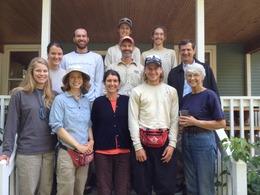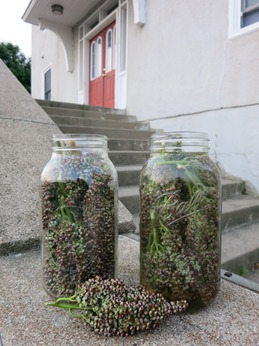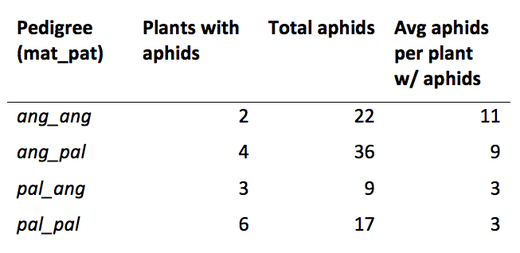|
|
This morning Team Echinacea was joined by special guest Steve Ellis, a commercial beekeeper based in Barrett, MN. Steve is also a national advocate for curbing the usage of neonicotinoid pesticides and has filed a lawsuit against the US EPA for sanctioning the widespread use of these chemicals in agriculture. While sipping on wild forage sumac-ade and devouring some delectable scones, the team was captivated by Steve’s description of the US pesticide regulatory system and the consequences of neonicotinoid usage. Neonicotinoids are a relatively new class of neuro-active insecticides used in agriculture throughout the US. Mounting evidence suggests these long-lived chemicals are at least partly responsible for the precipitous decline of commercial honeybee populations over the past 20 years. However, less is known about how neonicotinoids affect native pollinators, the birds and mammals that feed on pesticide-ridden insects, and the aquatic systems where neonicotinoids accumulate.

In other news, we finished measuring P1 before returning to the Hjelm House to celebrate Keaton’s birthday with cake and “exercises in estimation.”
While gazing up from measuring Dichanthelium today I spotted a large patch of fruiting sumac. The past summer I had been itching to make some sumac lemonade, and the abundant stand of smooth sumac (Rhus glabra) presented an irresistible opportunity!
After a quick and easy harvest of the fruits (called drupes) that are found in compound clusters at the end of branches, some team members and I returned for brewing.
There are many methods for making sumac-ade on the world wide web. The variables are sumac berries on or off the stem, the temperature of the water, and the duration of the soaking time. I decided to try out two at first, both leaving the fruits on the stem, one adding cold water and a longer wait time, and one where hot water is added and steeping only lasts 30 minutes. (Sumac is pictured below, jars thanks to Gretel and Stuart)

After many test rounds, two taste testers and I agree that the colder, longer brew time results in a more palatable, tart, and less bitter final product. The hotter, shorter method heats up the stems and causes them to release bitter sap. (In the picture below the sumac in the jar on the right was submerged in boiling water, and it is actively releasing sap).

Future projects include sumac-ade popsicles, as well as fruit drying for winter use and spice grinding.
Today we spent the morning doing remnant phenology. It seems that we are getting to the end of flowering and phenology is going faster and faster. During phenology we collected pollen that will be freeze dried and used for crosses next summer! Woah! While I was collecting pollen from the single flowering plant at the DOG site, the elusive three legged dog came to visit me. She fell down by me and panted while I collected the pollen. 
In the afternoon we furiously measured Experimental Plot 1. Gretel and I raced other groups aswell as each other, finishing four rows before we called it a day and headed in.
I can’t believe how quickly the past eight weeks have passed. Both my fellow Team Echinacea crewmembers and I have had great successes with our group and individual projects.
In exciting individual project news, Keaton and I have finished collecting observation data for my pollinator efficiency project! We were able to record over 175 visits, more than triple the number recorded last year. The work isn’t over yet though, as we still have to re-watch and re-name files for over 175 visits and analyze a (beautiful and majestic) mountain of data.
Here are some of the big numbers:
Greatest number of shriveled styles:
Date: July 23rd
Head: 10-13-grn
Pollinator: Andrena
Visit Duration: 3.25 minutes
Number of Shriveled Styles: 71
Longest Visit (based on videos watched thus far):
Date: July 23rd
Head: 17-26-yel
Pollinator: Andrena
Visit Duration: 12.15 minutes
Number of Shriveled Styles: 5
All though we still need to climb a few more pitches on data mountain before we can say with certainty, it appears as though long visits by Andrena do not necessarily result in more shriveled styles. Based on field observations, we believe this is because Andrena bees normally spend longer on the first heads they visit when their pollen baskets are un-filled with the compatible pollen required to cause style shriveling. The ideal visit duration seems to be 2-5 minutes for Andrena.
Well I better put my harness on and get back to climbing. The peak is in sight, but it will take some real finger strength and mental fortitude to reach it.
Cheers!
Maureen Page

This week I was able to share my work with my parents and my brother. My parents came out in the field on Thursday to learn about how we document phenology in the remnants. My mother expressed her surprise that the remnants are much smaller than she had expected. Stuart was in the field with us and gave my parents a detailed explanation of what we are doing this summer and answered all of my parents’ questions. Yesterday my brother drove up to visit me. I showed him Staffenson prairie reserve which has blooming blazing star, sunflowers, lead plant, Echinacea, wild onion, bergamot and more! It was fun to show my older brother around and finally get a chance to teach him a think or two.
These are my preliminary results after adding 2 aphids to each of the 80 plants in my experiment (20 of each variant) and checking on their survival after about a week:

The most interesting result is that aphids were able to survive on each variant, including Echinacea pallida (“pal_pal”). Lauren Hobbs and Hillary Lyon found that aphids did not survive on E. pallida in their experiment. If the aphids persist, it could challenge the species’ status as specialist. If they eventually die off, it could provide an insight into what makes E. pallida inhospitable to them.
Another result is that, while E. pallida had the most plants sustaining aphids and E. angustifolia the least, E. angustifolia had the highest average aphid load and E. pallida the lowest. Perhaps it is harder for aphids to colonize E. angustifolia but easier for them to persist once present. It is important to note that the plants in this experiment are only a year old, and so perhaps aphid survival is more affected by plant size than pedigree at this stage.
I am continuing my additions and observations with extra gusto, because I can’t wait to see if these trends bear out over repeated trials, or whether new ones will emerge.
Although Echinacea flowering is tapering off for summer 2014, the team is busy wrapping up phenology, collecting fitness data plants in the long-term experiments, and working on individual research projects. In addition to the projects well under way, the team has two more sizable projects on tap for August: conducting seedling searches and collecting demographic information on remnant populations.
On Wednesday, we were joined by Ruth, Amy, and Katherine to begin seedling searches at East Elk Lake Road. In what can only be described as a mentally demanding exercise, seedling searches involve locating and identifying seedlings from previous years using maps and distance matrices. Patience is of utmost importance when trying to solve Echinacea puzzles that may have 1 or many possible solutions…
|
|




-thumb-260x195-194150.jpg)

